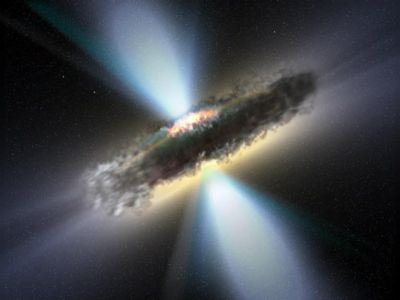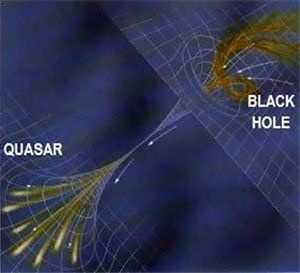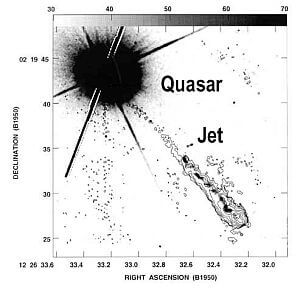Nautilus May 2014
 A black hole is a one-way door to oblivion. According to general relativity, once anything crosses its boundary—the event horizon—it cannot return to the outside. For that particle, the black hole is the entire future.
A black hole is a one-way door to oblivion. According to general relativity, once anything crosses its boundary—the event horizon—it cannot return to the outside. For that particle, the black hole is the entire future.
We’ll never actually get a chance to see the particle live out that destiny: Any light the particle emits (which would be the only way for us to observe its death plunge) will be stretched to longer and longer wavelengths with correspondingly less energy, until it fades beyond detectability. In fact, the story is even more strange. If we observe the particle falling in, we could never live long enough to see it reach the event horizon. The extreme gravity of the black hole makes time appear, to an outside observer, to go more slowly there; in fact, the particle would seem to us to take infinite time to reach the event horizon. That’s true even though from the particle’s reference frame, it crosses the event horizon unremarkably, with no unusual effects on time and space.
If a black hole is a one-way door to oblivion, you might wonder if there is any way to go the other way through the door—and it’s a good question. General relativity, which has been our standard theory of gravity for nearly 100 years, makes no distinction between past and future, time running forward and time running backward. (See physicist Sean Carroll discuss the time-symmetry of physics in his interview with Nautilus.) Newtonian physics also is time-symmetric in the same way. So the idea of “white holes”—black holes reversed in time—does make theoretical sense.
Like its opposite, a white hole has an event horizon, one which cannot be crossed from the outside. But white holes’ event horizons lie in the past: Particles originating there will appear to “fade in,” with increasing energy and wavelength of any light they emit. If a particle somehow came into existence inside that event horizon, it would be expelled to the outside.
In fact, everything about white holes just looks like black holes in reverse. General relativity has absolutely no problem predicting such a thing and describing it mathematically.
But do white holes exist in nature? And if they don’t, what does that say about the symmetry of time?
Seeing nothing vs seeing something
Black holes are common in the cosmos—nearly every large galaxy harbors a supermassive one in its nucleus, not to mention smaller specimens. However, astronomers have yet to identify a single white hole. That doesn’t rule out their existence entirely, since it might be hard to see one: If they effectively repel particles, there’s a small possibility they could be lurking out there somewhere, invisible. Nevertheless, none of all the diverse objects astronomers have observed seem to resemble what we’d expect from white holes.
An even larger problem arises when we consider how white holes could form. Black holes are the end result of gravitational collapse. When a star at least 20 times the mass of the Sun exhausts its usable nuclear fuel, it can no longer produce enough energy to balance the inward force of gravity. At that point, the core collapses on itself, reaching ever higher densities until its gravity is so intense that not even light can escape. That results in a black hole with a mass comparable to a large star.
Supermassive black holes, which are millions or billions of times heavier than that, form by some currently unknown mechanism. In any case, they still are the result of gravitational collapse, whether from a huge super-star born in the early days of the Universe, a huge cloud of gas at the heart of a primeval galaxy, or some other phenomenon. Forming a white hole, however, would require something akin to a gravitational sewer explosion, and it’s not clear how that sort of event could ever occur. One possibility is that white holes might be “glued” to black holes. In this view, a black hole and white hole are two sides of the same thing, connected via a wormhole, a concept familiar from many science-fiction stories. Unfortunately, as with forming white holes from scratch, this doesn’t really solve the problem: According to theory, any matter falling into the wormhole will cause it to collapse, closing the passage between the black and white holes. (It’s also technically possible to create a stable wormhole if “exotic matter” exists with negative energy—a similar principle proposed for a “warp drive”—but no evidence for such material exists.)
A matter of time
So we’re left with the probable conclusion that our Universe contains a multitude of black holes but no white holes. That’s not because of a fundamental asymmetry in time—general relativity still works just as well either way time flows—but due to the nature of gravitational collapse: It only works one way.
This parallels the situation with the entire cosmos: There was a Big Bang, an initial expansion of all we observe, apparently from a single point. But the evidence points pretty strongly against the possibility of a Big Crunch, a re-collapse of all we observe into a single point sometime in the distant future. If current trends continue (specifically if dark energy doesn’t drastically change its character), the Universe will continue to expand forever at an ever-faster rate. It seems there will be no symmetrical end to the Universe, where everything gets sucked back into a tiny singularity, just as it started.
The Big Bang actually looks like a white hole in many respects, and may be the closest our Universe ever gets to having one. It lies in the past for any observer in the Universe, and all we see expanded outward from it. However, it didn’t have an event horizon (meaning it was something called a “naked singularity”, which is far less kinky than it sounds). Despite that, it resembles gravitational collapse in reverse.
Just because the equations of general relativity allow white holes and big crunches, warp drives and wormholes, doesn’t mean these things actually exist in nature. The asymmetry of time in gravity isn’t inherent, but seems to arise from the behavior of matter and energy: gravitational collapse at the end of time, initial expansion at time’s beginning. The deep meaning of that is something physicists are still trying to comprehend.
Matthew Francis is a physicist, science writer, public speaker, educator, and frequent wearer of jaunty hats. He’s currently writing a book on cosmology with the working title Back Roads, Dark Skies: A Cosmological Journey.
 Tray S Caladan – Here’s what really happens when you enter the vortex of a Black Hole: You do not get crushed into a ‘singularity.’ You warp or pour down and down and down a ‘Super Funnel’ and are fine, unscathed…and you exit a QUASAR on the molecular level! Take 2: Quasar on the molecular level!!
Tray S Caladan – Here’s what really happens when you enter the vortex of a Black Hole: You do not get crushed into a ‘singularity.’ You warp or pour down and down and down a ‘Super Funnel’ and are fine, unscathed…and you exit a QUASAR on the molecular level! Take 2: Quasar on the molecular level!! Haven’t you figured it out? QUASARS ARE WHITE HOLES
Haven’t you figured it out? QUASARS ARE WHITE HOLES
 Dmitry Orlov – A while ago I had the pleasure of hearing Sergey Glazyev—economist, politician, member of the Academy of Sciences, adviser to Pres. Putin—say something that very much confirmed my own thinking. He said that anyone who knows mathematics can see that the United States is on the verge of collapse because its debt has gone exponential. These aren’t words that an American or a European politician can utter in public, and perhaps not even whisper to their significant other while lying in bed, because the American eavesdroppers might overhear them, and then the politician in question would get the Dominique Strauss-Kahn treatment (whose illustrious career ended when on a visit to the US he was falsely accused of rape and arrested). And so no European (never mind American) politician can state the obvious, no matter how obvious it is.
Dmitry Orlov – A while ago I had the pleasure of hearing Sergey Glazyev—economist, politician, member of the Academy of Sciences, adviser to Pres. Putin—say something that very much confirmed my own thinking. He said that anyone who knows mathematics can see that the United States is on the verge of collapse because its debt has gone exponential. These aren’t words that an American or a European politician can utter in public, and perhaps not even whisper to their significant other while lying in bed, because the American eavesdroppers might overhear them, and then the politician in question would get the Dominique Strauss-Kahn treatment (whose illustrious career ended when on a visit to the US he was falsely accused of rape and arrested). And so no European (never mind American) politician can state the obvious, no matter how obvious it is. A black hole is a one-way door to oblivion. According to general relativity, once anything crosses its boundary—the event horizon—it cannot return to the outside. For that particle, the black hole is the entire future.
A black hole is a one-way door to oblivion. According to general relativity, once anything crosses its boundary—the event horizon—it cannot return to the outside. For that particle, the black hole is the entire future.